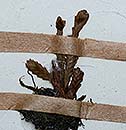Cochlidium serrulatum (Sw.) L.E. Bishop
Synonyms |
Grammitis serrulata (Sw.) Sw. |
|---|---|
Common name |
|
Description |
Rhizome erect, up to 1 mm thick; rhizome scales brown, lanceolate in outline, up to 1 mm long. Fronds tufted, erect, firmly membranous, subsessile, fertile fronds longer than sterile fronds. Stipe very short, brown, glabrous. Lamina up to 35 × 2 mm, glabrous, linear to very narrow oblanceolate in outline, base long tapering, apex broadly acute to rounded, deeply pinnatifid about halfway to the midrib into acute triangular or oblong obtuse lobes each with a single conspicuous vein, midrib immersed. Sori 6-8 per frond, borne on the veins in the widened upper third part of the frond, fusing to form a soral mass at maturity. |
Notes | Can be distinguished from other species by its simple toothed fronds. |
Derivation | serrulata: finely toothed, referring to the margins of this species. |
Habitat | Quartzite boulders in low-altitude evergreen forest. |
Distribution worldwide | Africa, Madagascar. |
Distribution in Africa |
Cameroon, Equatorial Guinea (incl. Bioko), Gabon, Guinea, Ivory Coast, Liberia, Rwanda, Sierra Leone, Zimbabwe. |
Growth form |
Epiphytic, lithophytic. |
Literature |
|

